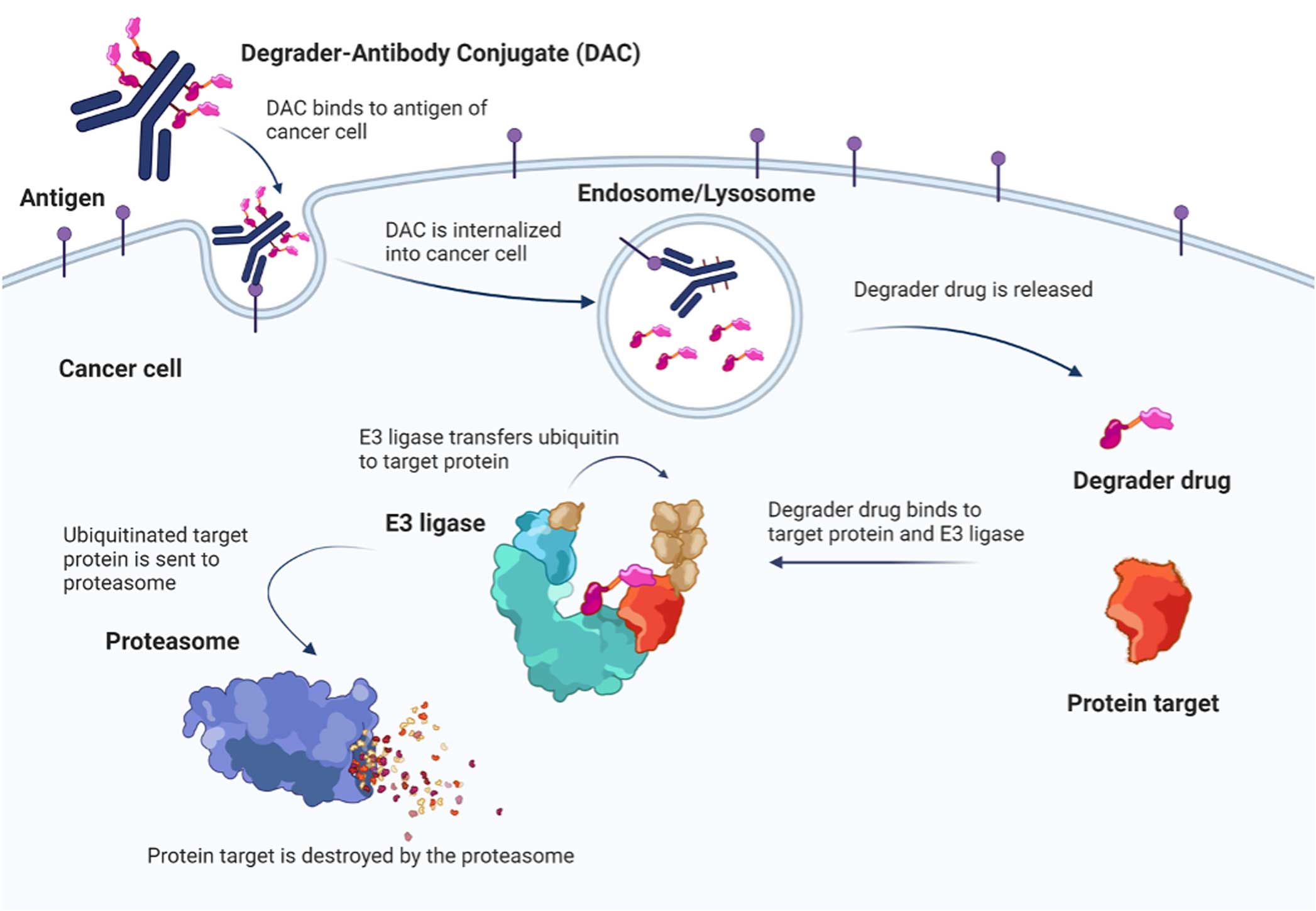Degrader-Antibody Conjugates (DACs): Targeted Protein Degradation for Therapeutics
In the realm of targeted therapeutics, Degrader-Antibody Conjugates (DACs) have materialized as a beacon of innovation. DACs represent a vanguard therapeutic frontier, harnessing the synergistic potential of antibodies and PROTACs (Proteolysis Targeting Chimeras). At their core, DACs embody a harmonious fusion of specificity and catalytic degradation, promising revolutionary advancements in disease management.
Illustration of Degrader-Antibody Conjugates (DACs)

How DACs Work: Antibodies for Targeting, PROTACs for Degradation
Antibodies, adept at recognizing specific cellular targets like a lock and key, serve as the linchpin of DAC functionality. These specialized proteins zero in on antigens, unique markers residing on the surface of cells, acting as precise homing beacons. PROTACs, on the other hand, are small molecules with dual binding sites.
One site latches onto an unwanted protein, effectively marking it for elimination, while the other anchors an E3 ubiquitin ligase – a molecule integral to the cellular waste disposal mechanism. Through this ingenious union, PROTACs reroute the cell’s natural protein recycling machinery to destroy the targeted protein.
Constructing DACs: The Science Behind Targeted Therapies
A DAC is meticulously assembled by chemically interlinking an antibody to a PROTAC molecule. Upon administration, the antibody component of the DAC expertly navigates the biological landscape, seeking out cells adorned with the target antigen. Once docked, the DAC-cell complex is internalized within the cell.
Upon release, the PROTAC component exerts its destructive influence, bridging the targeted protein and the E3 ubiquitin ligase. This molecular handshake culminates in the doomed protein being adorned with ubiquitin molecules, an unequivocal “kiss of death,” signaling its impending destruction by the proteasome, the cell’s waste incinerator.
Advantages of DACs: Specificity, Potency, and Overcoming Limitations
DACs offer several compelling advantages over conventional therapeutics. The precision targeting bestowed by antibodies significantly enhances specificity, thereby minimizing collateral damage to healthy cells – a hallmark of traditional treatment modalities. In addition, PROTACs (and by extension, DACs) act catalytically, enabling the repeated disposal of undesirable proteins within the cell.
This amplifies their potency compared to approaches requiring a one-to-one stoichiometric drug-to-target ratio. Furthermore, DACs have the capacity to circumvent limitations traditionally associated with PROTACs, exploiting the inherent ability of antibodies to reach diverse cell types and anatomical locations.
DAC Applications: Cancer, Neurodegeneration, and Beyond
The potential applications of DACs are immense, particularly within the cancer arena. The capacity to precisely target proteins integral to tumorigenesis or those responsible for immune system suppression holds the promise of revolutionary cancer therapies. Additionally, DACs show tremendous promise in combating neurodegenerative diseases – clearing the detrimental build-up of toxic proteins characteristic of conditions such as Alzheimer’s and Parkinson’s represents a new front of exploration.
In essence, DACs open the door to therapeutic modalities targeting numerous diseases where the selective elimination of specific proteins plays a pivotal role in overcoming the underlying disease pathology.
DACs: Early Successes and The Future of Targeted Medicine
This emerging therapeutic paradigm remains in its relative infancy, yet its exponential potential has fueled both optimism and rapid advancement. Early clinical studies provide encouraging preliminary results, solidifying the belief that DACs may redefine how we manage and treat a myriad of complex diseases.
The future is rife with exciting possibilities as researchers continue to unravel the potential of DACs, propelling us towards an era of personalized, targeted therapies with transformative outcomes.
©www.geneonline.com All rights reserved. Collaborate with us: service@geneonlineasia.com









